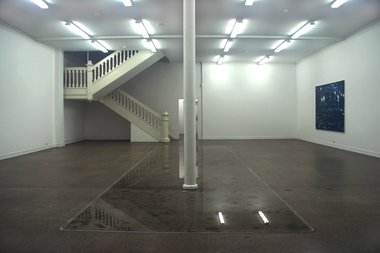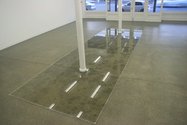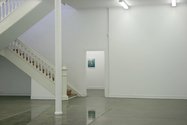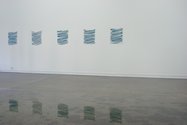John Hurrell – 13 July, 2013
Moving around in order to stumble upon key vistas means drifting through 'dead' space, as say with an anamorphic drawing. That ‘drifting' is an important aspect of looking at the elements separately, such as thinking about the mottled patches of the concrete under the water where water has got under the sealant, or the sag lines of the hanging pieces of silk, the wrinkles where the fabric's weight ripples the supersoft material.
A low rectangular pool of water in the middle of the space is something you do not encounter in a gallery very often; a shadow slab of still reflective liquid on the concrete Starkwhite floor, strategically positioned to mirror - for the attentive circumnavigating visitor - the gallery lights and nearby paintings; paintings that examine light bouncing off waves of water.
So in Trenton Garratt‘s exhibition there is this circularity, a wit about these materials referencing themselves (also repeated in five ‘schematic’ paintings of light on rippled water, rendered on silk - its ultra soft surface being a substitute for the ‘skin’ of a liquid), and modes of representation, plus an interest in Chinese culture and the role water plays in architecture there, water perceived as inherently having a stabilising and tranquil influence.
The largest painting, Fishing for the Sun, is a gorgeous close up of the churning restless sea with sunlight ricocheting off its surface. With its colour and highlighting it owes a lot to Edward Ruscha, though Ruscha is interested in (behind language) smudgy space and ether where Garratt is fixated on looking at, on and through water. The immensity of the turbulent boundless fluid, its hidden power, is offset by delicate flicks of foam alongside bobbing (sun) balls of streaking white, resolutely clinging to the surging undulating bumps. It exudes a latent violence unleashed.
Two other works in the Starkwhite office (Deep Blue) are more perspectival in their depiction of waves and so have an affinity to the stylised ripples of the taped up silk paintings. There is also a suggestion of desert sands (rows of dunes), isolation and great heat.
Thinking about the visitor and their wanderings around the downstairs space, their experience is of course quite different from a photographer setting up shots that visually connect spatially separated components - so that in an image distance becomes condensed. Moving around in order to stumble upon key vistas means drifting through ‘dead’ space, as say with an anamorphic drawing. That ‘drifting’ is an important aspect of looking at the elements separately, such as thinking about the mottled patches of the concrete under the water where water has got under the sealant, or the sag lines of the hanging pieces of silk, the wrinkles where the fabric’s weight ripples the supersoft material. Pondering the parts, their physical peculiarities, beyond the experiential whole.
John Hurrell










 Advertising in this column
Advertising in this column Two Rooms presents a program of residencies and projects
Two Rooms presents a program of residencies and projects



This Discussion has 0 comments.
Comment
Participate
Register to Participate.
Sign in
Sign in to an existing account.